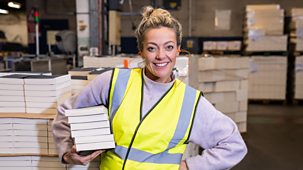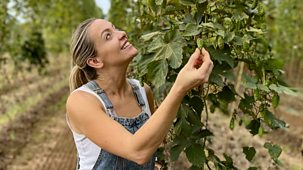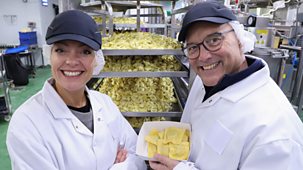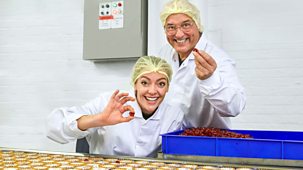
Series 9: 1. Chocolate Seashells
Paddy McGuinness is fully immersing himself in the festive spirit as he explores a huge chocolate factory in Belgium. With lots of taste tests to enjoy along the way, he embraces the fantastic processes and surprising science that enable the epic production lines to knock out four million individual chocolates every day. And they’re especially busy in the run-up to Christmas. \n\nPaddy is at the Guylian chocolate factory, on the outskirts of the very Christmassy-sounding city of Saint Niklas in Belgium, to learn how they produce chocolate seashells ready for the Christmas rush. He begins by meeting Kevin Stevens at the factory’s intake bay to welcome in a bumper delivery of hazelnuts from Turkey. Kevin tells Paddy that the hazelnuts are a key component in the praline filling inside each of the chocolate shells. \n\nOnce the sacks of nuts are safely inside the warehouse, Paddy is chuffed to learn that the size of the nuts is very important. They must be between 8 and 11 millimetres; any bigger and they’ll be too fatty, any smaller and they’ll be too dry. Luckily, Paddy’s nuts make the grade, and he follows 7,500 kilograms of them inside the factory. \n\nResplendent in his factory hairnet, Paddy’s next stop is the intriguingly named Kettle Room. As he enters, he is blown away by the delicious smell and intrigued by the traditional-looking machinery. With the help of an automated shoot, a torrent of hazelnuts and refined white sugar cascades into one of six copper kettles. The kettles are heated to around 140 degrees Celsius, which roasts the nuts to draw out their subtle flavours. At the same time, the sugar caramelises. The result is a beautifully sweet, nutty mixture. The problem is, it’s too chunky to be anywhere near a smooth praline paste. To solve this, the mixture is sent through a mincer, which produces a fine crumb with a melt-in-the-mouth texture. Paddy is in heaven in his first of many taste tests. Then things get even better, as milk chocolate is added to produce a velvety smooth hazelnut praline. \n\nWith the centre of his chocolates made, Paddy is guided to the enormous, automated seashell production line. Two thousand six hundred moulds in the shape of different seashells continuously travel through the line. As they make their way along, half receive a splash of white chocolate and half a splash of milk chocolate, then an additional layer of chocolate is added to create the marbled effect that the finished chocolates are known for. In a surprising twist, each and every mould is flipped upside down, letting the chocolate pour out. But Paddy needn’t worry; it’s all part of the plan to ensure the perfect amount of chocolate is left in the moulds to create the outer shell. After travelling through a cooler, it’s time for the hazelnut praline that Paddy helped to make earlier. Eighty-eight taps gently release an average of 6.8 grams of the praline filling into each half of the chocolate shells. Then, to complete the seashell shape, the two moulded halves are joined together. Just three hours and five minutes after the start of production, Paddy delights in the sight of finished chocolate seashells streaming past him, and he can’t help but get stuck into one - or two! \n\nAs the final act of this sweet Christmas drama draws to a close, the chocolates head to the packing area, where they’re dropped into blister packs and then slid inside cardboard boxes and sent to the dispatch area. And because the site is so large, there’s only one way to get there – by bicycle! The six-year-old Paddy couldn’t have dreamt of a better Christmas present: riding a bike through a chocolate factory.\n\nFour hours and twenty-five minutes after the start of production, Paddy waves off a lorry load of chocolate from one of the loading bays. From the factory in Belgium, the seashells head off all over the world. But it’s the Brits who eat the most at Christmas, putting away a whopping 44.7 million chocolate shells over the festive period! \n\nElsewhere in the episode, Cherry is also in Belgium, at another massive chocolate factory, learning how they produce the white chocolate used in Paddy’s chocolate seashells. And she enlists the help of mathematician Bobby Seagull to explore the art, or rather the maths, of Christmas tree decoration. \n\nAnd historian Ruth Goodman is in Belgian too, exploring how Belgian chocolate has become world-famous, and she delves into the European origins of Santa Claus.
Source: BBC 2
Most recent episodes of Inside the Factory
Inside The Factory
Series 9: 6. Sausage Rolls
Paddy McGuinness explores the secrets of the McColgan’s bakery in Strabane, Northern Ireland, to reveal how it makes more than half a million sausage rolls a day. \n\nAft ...
09-02-2025
BBC 2
Inside The Factory
Series 9: 5. Hardback Books
Paddy McGuinness visits the Clays book factory in Suffolk to learn how they produce 20,000 copies of Pride and Prejudice for publisher Penguin. The factory makes an astonishing ...
02-02-2025
BBC 2
Inside The Factory
Series 9: 4. Flapjacks
In this episode, Paddy McGuinness explores the secrets of the Graze factory in west London, revealing how they make 40 million flapjacks a year. \n\nArmed with a trusty tasting ...
26-01-2025
BBC 2
Inside The Factory
Series 9: 3. Cheese Curls
In this episode, Paddy McGuinness explores the secrets of the Walkers factory in Lincoln, to reveal how it makes 500 million packs of Quavers every year. \n\nPaddy begins by mee ...
19-01-2025
BBC 2
Inside The Factory
Series 9: 2. Sliced Bread
In a nostalgic episode of Inside the Factory, new presenter Paddy McGuinness visits the Warburtons bread factory in his hometown of Bolton, where he once worked as a youngster m ...
12-01-2025
BBC 2
Inside The Factory
Series 9: 1. Chocolate Seashells
Paddy McGuinness is fully immersing himself in the festive spirit as he explores a huge chocolate factory in Belgium. With lots of taste tests to enjoy along the way, he embrace ...
28-12-2024
BBC 2
Inside The Factory
Series 8: 7. Carpets
Gregg Wallace explores the Axminster factory in Devon to reveal how it produces 46,000 square metres of carpet every year. He follows the production of one of their best sellers ...
15-11-2024
BBC 2
Inside The Factory
Series 8: 6. Bath Bombs
Gregg Wallace visits the colourful and fragrant Lush factory in Dorset to learn how an astonishing 14 million bath bombs are produced every year.\n\nCherry Healey visits Loughbo ...
09-10-2024
BBC 2
Inside The Factory
Series 8: 5. Stout
Gregg Wallace explores the secrets of the Guinness brewery in Dublin to reveal how it makes two million litres of Irish stout every single day.\n\nCherry Healey visits a water t ...
02-10-2024
BBC 2
Inside The Factory
Series 8: 4. Stuffed Pasta
Gregg Wallace explores the Dell Ugo factory in Hertfordshire to reveal how it makes 500 million stuffed pasta parcels every year. \n\nHe’s following production of one of ...
25-09-2024
BBC 2
Most popular episodes of Inside the Factory
Inside The Factory
Series 9: 3. Cheese Curls
In this episode, Paddy McGuinness explores the secrets of the Walkers factory in Lincoln, to reveal how it makes 500 million packs of Quavers every year. \n\nPaddy begins by mee ...
19-01-2025
BBC 2
Inside The Factory
Series 9: 4. Flapjacks
In this episode, Paddy McGuinness explores the secrets of the Graze factory in west London, revealing how they make 40 million flapjacks a year. \n\nArmed with a trusty tasting ...
26-01-2025
BBC 2
Inside The Factory
Series 9: 5. Hardback Books
Paddy McGuinness visits the Clays book factory in Suffolk to learn how they produce 20,000 copies of Pride and Prejudice for publisher Penguin. The factory makes an astonishing ...
02-02-2025
BBC 2
Inside The Factory
Series 8: 2. Jelly Beans
Gregg Wallace explores the Jelly Bean Factory in Dublin to reveal the incredible processes it employs to make ten million colourful little sweets every day.\n\nCherry Healey vis ...
05-09-2024
BBC 2
Inside The Factory
Series 5: 1. Cherry Bakewells
Gregg Wallace is in Stoke-on-Trent at an enormous cherry bakewell factory where they produce 250,000 little tarts every day. He follows the production of cherry bakewells, from ...
03-08-2023
BBC 2
Inside The Factory
Series 6: Ice Cream
Gregg Wallace visits a family-run factory in the heart of rural Aberdeenshire, which churns out more than 49 tonnes of dairy ice cream every day. Gregg is delighted to learn he& ...
21-05-2023
BBC 2
Inside The Factory
Series 7: Vegan Sausages
Gregg Wallace visits a Yorkshire team that churn out up to 90,000 vegan sausages a day! Heck have been making these bangers since 2018, and the process is surprisingly futuristi ...
30-07-2024
BBC 2
Inside The Factory
Series 4: 9. Pencils
Gregg Wallace is in Germany, at a historic factory which produces 600,000 pencils a day. At materials intake he is astonished that the main material in a pencil is not lead, but ...
16-04-2019
BBC 2
Inside The Factory
Series 8: 10. Paint And Wallpaper
Gregg Wallace explores the Farrow & Ball factory in Dorset to learn how they produce up to 200,000 litres of paint and 10,000 metres of wallpaper a week. They make 270 different ...
15-03-2024
BBC 2

















